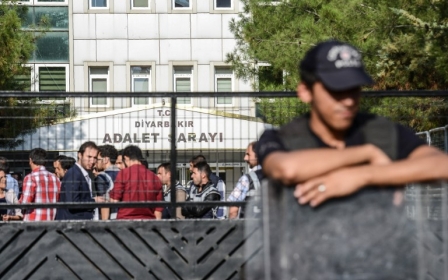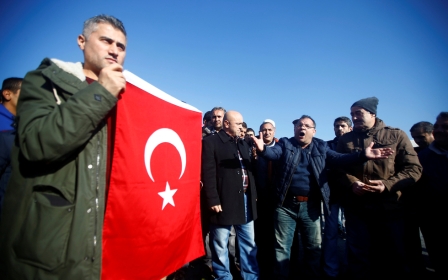How the Turkish army and Kurdish fighters reduced this town to ruins

The list of towns and cities in the Middle East currently lying in ruins gets longer every year.
One of the latest additions is Sirnak in southeast Turkey. Fighting between government security forces and Kurdish militants since March has transformed the mountainous town into a setting reminiscent of Aleppo or Gaza.
Thousands of buildings have been gutted and scores killed. The exact details are still hard to ascertain due to the restrictive measures taken by the government against reporting in the region. According to the environment and urbanisation ministry, 14,727 houses were assessed for damage and 2,044 houses were marked for demolition.
Asya, 42, and her family saw their homes obliterated in the fighting. “Nine months ago we had six flats in Sirnak but when the conflict started we fled,” she says, speaking to Middle East Eye. "We could only take some clothes with us; all I could bring was one bag. We fled to the city of Siirt with our eight children.
“Our city was under curfew for eight months so we rented a flat in Siirt. My husband couldn't find a job there. One of my sons is working, he is 17 years old, and he earns 1200 lira from which we have to pay rent of 750 lira for the flat. We can only just afford a few things to eat. Before we had six flats but now I have nothing.”
'Before we had six flats but now I have nothing. I visit the remains of my home every day'
- Asya, resident of Sirnak
“I visit the remains of my home every day. This rubble is all I have now.”
Permanent checkpoints now exist at the entrance to Sirnak. Rubble is strewn everywhere, with even the mosques at the centre of the town heavily damaged in the clashes. Entire city blocks have been reduced to debris.
Formerly prosperous business owners have found themselves thrust into poverty and thousands are thought to be homeless.
Halil Ozen, 62, sent a petition to the soldiers securing the area after his house was destroyed, asking for support to rebuild.
"The governorate announced that it will give us new flats after one year," he says.
"The governorate claims 2,000 flats were destroyed but it is not true. The governorate plans to build 6,000 new flats, and why? Because they know more than 6,000 were destroyed.”
Turkey’s Kurdish-majority southeast has been a hotbed of violence since the collapse of a ceasefire between the PKK and the Turkish state in July 2015. According to the International Crisis Group, at least 2,473 people have been killed in the current round of fighting, which has also spilled over into bomb and suicide attacks in the western cities of Istanbul and Ankara.
In Sirnak, as in Diyarbakir, Cizre and other cities in the southeast, militants belonging to the Patriotic Revolutionary Youth Movement (YDG-H), often referred to as the PKK's youth wing, set up barricades and took up arms declaring autonomy from the Turkish state. The response was an 82-day operation by the military to regain control of the town and wipe out the militants' presence.
'If I didn’t know I was in Sirnak, I would assume I was in Aleppo or a city in the West Bank'
- Mehmet Ali Aslan, HDP lawmaker
For many older residents of Sirnak such as Halil, the violence must have been painfully familiar. In 1992, at the height of the PKK war, similar fighting led to the flight of 20,000 of the town’s then 25,000 population. The Turkish military bombarded the town for three days, reducing much of it to rubble. Though the administration has changed and the PKK no longer seeks an independent Kurdish state, the tensions that then existed between what is seen as an exclusionary Turkish nation and the Kurds still persist.
"Some of us used to think that if we had equal rights, we could live with the Turks,” said one Sirnak resident in 1992, in an interview with the New York Times. “But not many people think like this any more."
What happens next?
“If I didn’t know I was in Sirnak, I would assume I was in Aleppo or a city in the West Bank," he told an investigatory committee in late November. "If a city was destroyed like this in another country, the media would broadcast that, but in Turkey, crippled by disinformation, they don’t."
READ: The inevitable confrontation between Turkey and Syrian Kurds
The government has already promised a new reconstruction project in the southeast: in September, the environment and urbanisation minister promised that 30,000 houses would be built in the region following the cessation of violence.
The Sirnak government website already hosts an artist's impression of what the new project will look like:
But even promises of reconstruction raise new concerns for Kurds.
Ali Bayram, a lawyer from the town, explains that the new conditions imposed upon the residents will see them relocated from the site of their original properties.
"The state plans to sign a contract with every landlord, and they have no choice whether to accept or decline the terms, and they will be given a new flat but will also be forced to sell the plot of land on which their original home was," he tells MEE, citing information released by the governorate's office.
“As far as we can tell, homeowners will be given new flats but on new land, not where their homes were, in other neighbourhoods entirely.”
The government has frequently pinned the blame for the destruction in Sirnak and elsewhere in the southeast exclusively on the PKK and other Kurdish militants. Surnak governor Ali Ihsan Su has promised that their victims in the region would be compensated.
But some locals fear they will lose out on compensation if they have no proof of their ownership of their properties, something which is not uncommon.
“I used to own six flats and four shops - we have official papers to show this - but all our possessions in the shops were burned and we cannot prove it," says Semsettin Baris, a local businessman. “There used to be so many mini-shops in Sirnak and those people did not have official papers."
READ: Kurds are paying the price of Turkey's post-coup crackdown
Another widespread conspiracy theory has it that the government plans to rehouse Syrian refugees, who number more than 2.75 million in Turkey, in the new properties in the southeast. Suggestions in recent months by Turkish President Recep Tayyip Erdogan that refugees - who are overwhelmingly based in the southeast - could be given citizenship have raised fears about a “social engineering” project that could inject a large number of Arabs into the region’s Kurdish-majority demographics.
Aycan Irmez, a local MP for Sirnak, has also repeated the claim, telling the pro-Kurdish Firat News Agency that the government had "a single goal: to depopulate this area, change the demographic and assimilate the people."
While the evidence of such a scheme isn't exactly forthcoming - and is thoroughly denied by the government - the idea has still been planted in the heads of many Kurds, who now fear that they are being slowly marginalised in their historic homelands.
“No one here can explain the whole truth for you – we are afraid,” says one Sirnak resident, who didn't want to give his name.
“We think they will take Arab refugees to live in the new flats. Two thousand flats have been destroyed but the state is building 6,000. Maybe the state will sell us the 4,000 flats and earn money.”
MEE contacted the Sirnak governorate for a statement but received no response. “We gave out all information through official channels and we will not answers any questions," they said.
Sirnak, like much of the southeast, has felt the constant ebb and flow of the PKK-Turkey war since it began in 1984. While the Turkish army is most often the subject of residents' anger, many also blame Kurdish militants, often arguing that “if they hadn’t brought the clashes to the city centre, this wouldn’t have happened”.
Repeated attacks by alleged PKK militants in urban centres and continuing operations by the Turkish state mean that a solution to the current crisis appears less and less likely in the near future.
This article is available in French on Middle East Eye French edition.
Middle East Eye propose une couverture et une analyse indépendantes et incomparables du Moyen-Orient, de l’Afrique du Nord et d’autres régions du monde. Pour en savoir plus sur la reprise de ce contenu et les frais qui s’appliquent, veuillez remplir ce formulaire [en anglais]. Pour en savoir plus sur MEE, cliquez ici [en anglais].











